21.6.2025
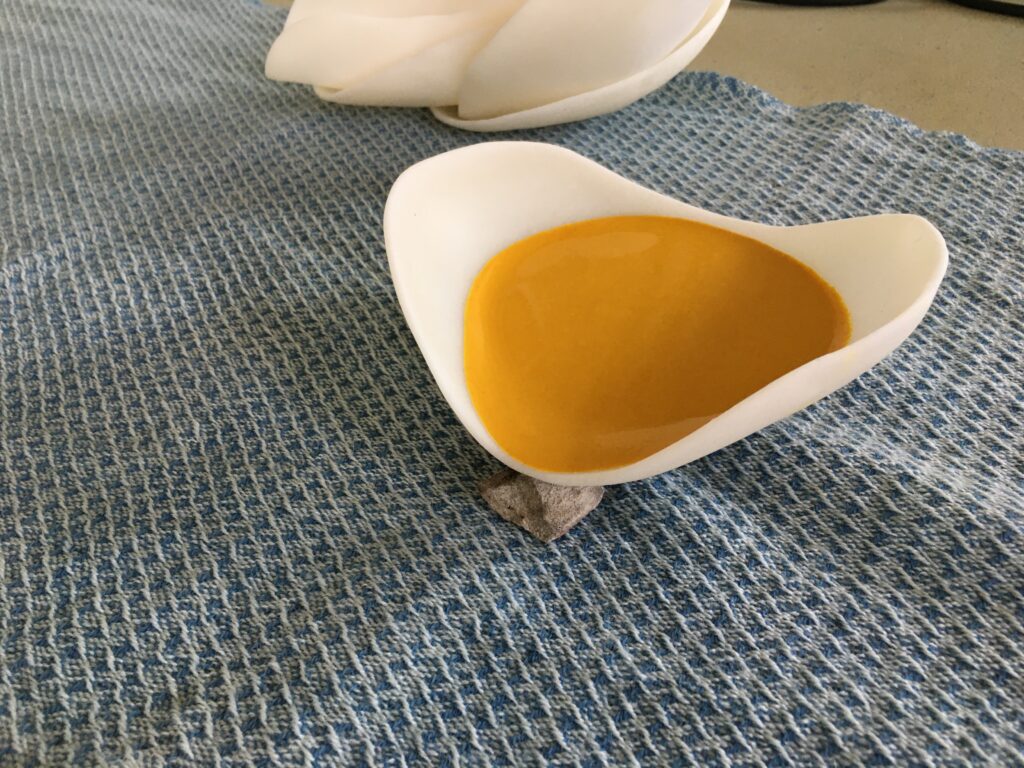
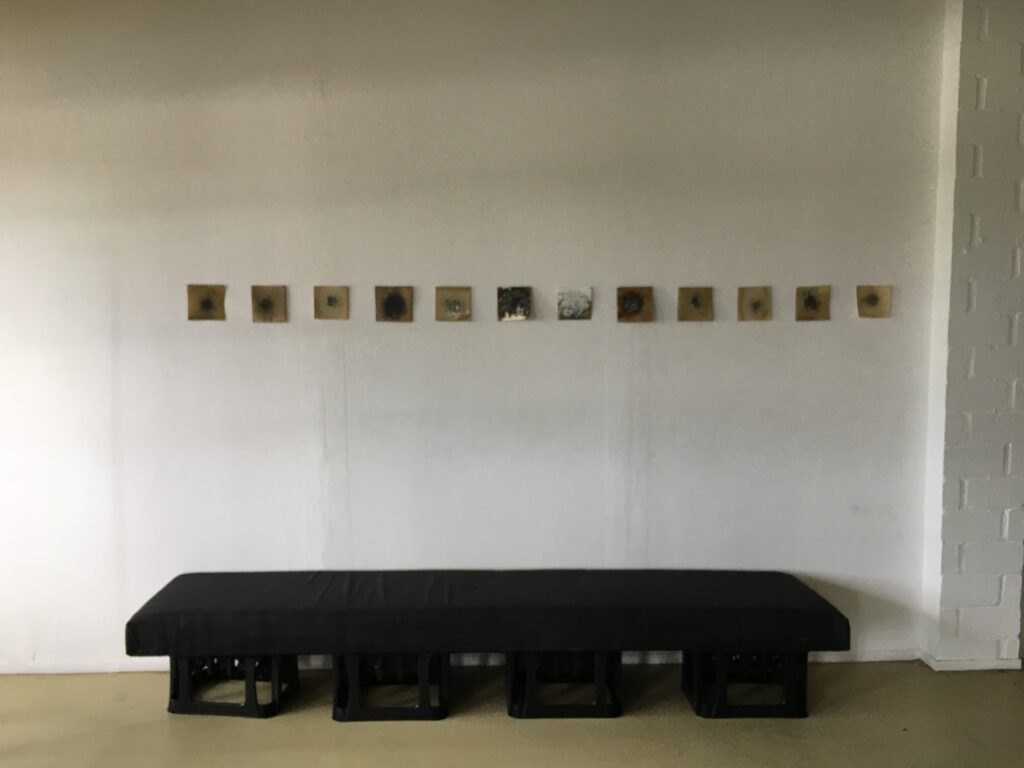

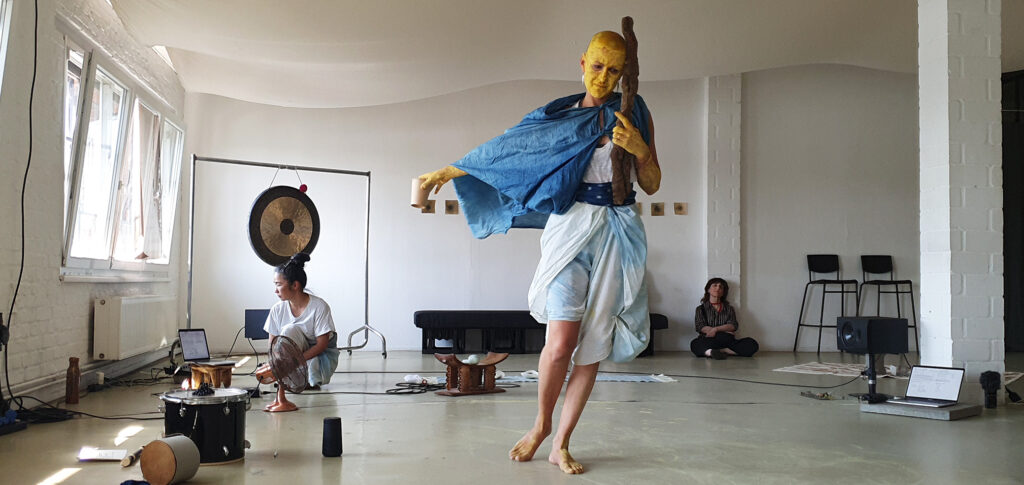
Saturday’s sharing was a durational event. It began at 2pm / 14:00 in Backstein Boot’s project space. We had set up the installation guided by the arcitecture of the Yagya Shala (a large-scale yantra), a sacred space for conducting rituals. There is a small indigo vat, some sukumo, ash water, indigo plant seeds, hardwood ash, lime powder. The indigo vat is placed on top of a simple yantra with the intention that when Mika stirred it, some of the indigo mixture might spill over. The yantra score will then be carried forward into another Yaga Shala, as a resonance from this moment in time – this stirring of time.
The gong was time-keeper and the other objects included instruments, the sound system and speakers, the bowls containing ash, lime powder, sukumo, turmeric and some of my hair. The indigo prints, were set up in a row of 12: four per week.
The installation was composed as a space that enables metamorphosis over time.
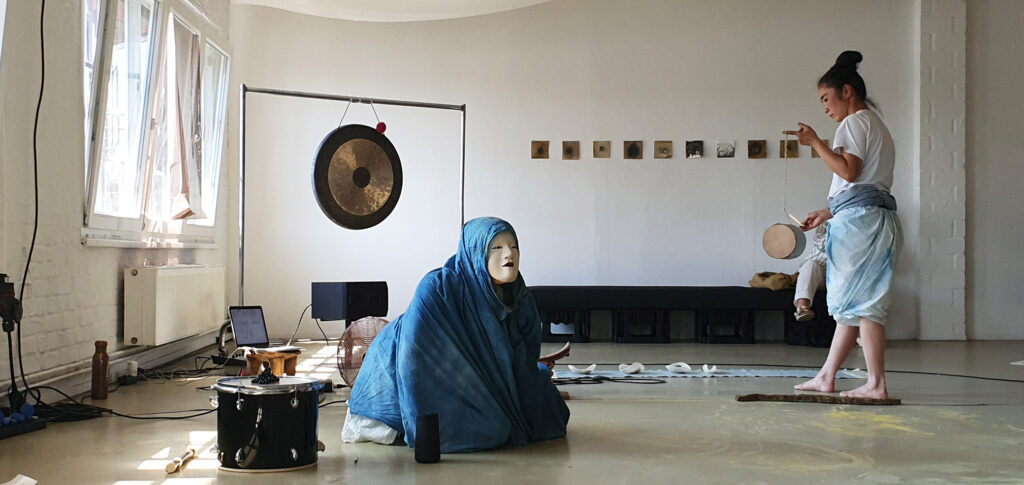
We began at exactly 2pm. It felt like diving in. I didn’t know if the system was on or not. I just needed to follow what I was being given, in the moment. I could feel a strong connection with the audience and it felt as if I had to be hyper-focused on what was emerging from the system, for them, to be present with me within this ‘non-sense’; for them to ‘know’ that it was ok to be in the ‘unknown’, that it was navigable through certain ways.
None of it was rehearsed, I was constantly following the flow of improvisation. Sometimes there was an inner voice reminding me that I hadn’t yet worked with the larger bell, and maybe it was time to do that. But another more playful voice was refusing to follow orders and saying ‘wait, wait… it’s not for now, maybe it will come and maybe it won’t’. I have never felt so much trust in a process, that I could just keep going for 2+ hours, and I could have gone on.
Mika did more than I thought, and maybe more than she thought too. This was an added variable, I had to be attentive to her presence and the energy of what she was doing, not to interfere or take over with how I was responding: it became a duet+. She was in the process of ritualizing the process of indigo – ‘ritualizing’ in that she was doing the activity in a setting where indigo would probably not occur, but the gestures associated with the process brought indigo into the time-based composition.
Mia the cat came in and our bodies resonated for a while both responding to floor, to sound, to space and to the bodies and presences around us.
I felt a deep connection with the audience, their curiosity sustained the emergence of what wanted to emerge… and I noticed people began to close their eyes, to let themselves daydream and go inside. Sure, the drone of the voice model allows that, but was it only that?
In ancient Noh theatre, when plays lasted for days, people would come and go, they would sleep and dream. The dreaming has always been part of Noh. It’s the same as what I felt when I first saw Butoh (I write about it in the intro to my book).
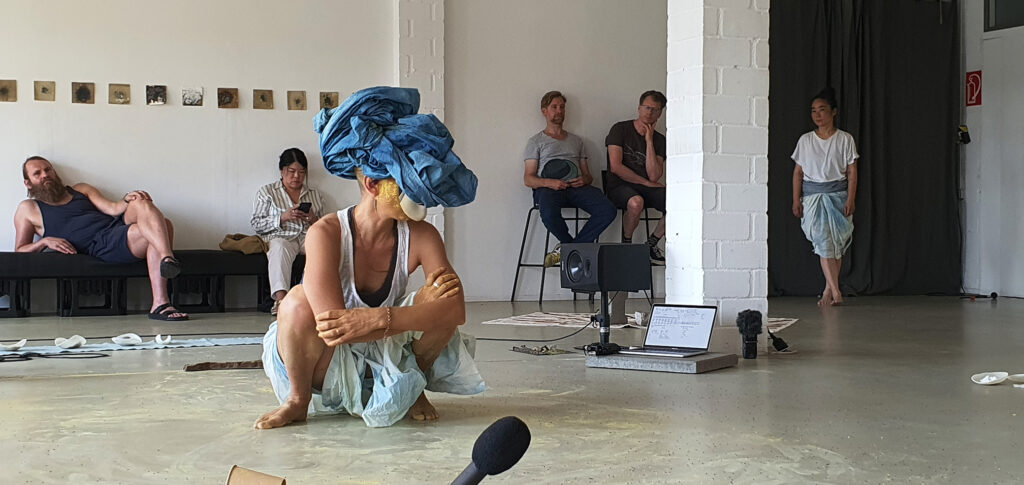
Reflections after the process:
I still don’t want to use the word ‘performance’ to describe what happened today… I prefer the word ‘activation’: energy is being stirred up, there is a metabolic aspect to what happens in this space, it’s energetic and not in search of form or representation of anything. None of this was rehearsed: many in the audience were surprised when I told them this. Why?
I made myself a loose score that would help me be present. My presence might make others more present: I am not telling a story.
An activation enlivens spacetime as a whole, not just the body of the performer offering something to a viewer. An activation propagates a collective experience of unknowing.
Yes, perhaps there is a configuration which suggests performance: a person, two people sometimes, human bodies engaged in some movement, some activity. Other human bodies surround this space and watch: they do not feel like they should cross a certain boundary. Does this make it a performance?
Rituals are also like this. Some people carry out the ritual while others are present to make it happen, to activate it. This is not about ‘suspending disbelief’ as in theatre, but setting off a dance with time through the presence of the objects and elements of the installation. In this case, a major aspect is the droning voice of the AI model.
For someone like G, it seems the presence of AI was absolutely primary. Was this our intention? Should we have been more clear about how/why we were working with this model, and the technical details of how the RAVE model was developed. Do people need all this information from the start?
How much do people need to know before they enter the space?
How can we involve the audience in the activation without making them ‘press buttons’ as a form of participation?
What is a ‘score’?
I say that Scores for Unknowing are Devices for Remembering (my inspiration comes from the I-Ching): can we remember the meaning each one of us has in the world? These are not scores in the way Hijikata was choreographing, but rather devices that allow freedom, free time – sleeping is okay! – diverse embodiments. What is auto-choreography as a social and political practice? What are the ethics of non-sense and how do we put them into practice? The score is like a buoy rather than a road sign. Scores for unknowing are about training for complexity – indigo, AI, other people. Is Tai-Chi, with the notation being descriptive image forms mostly linked to animal behaviours, and the Taoist system that includes the I-Ching, a ‘score for unknowing’? I think yes.
A score would transmit information; what kind of information? Is there a notation? Is it graphical?
Why did we use the RAVE model? Did we need it throughout?
What do we know about the voices used to train it? Why are there no children’s voices? Why do they all sound anglophone? Do we want to create our own somewhere down the line? What is the carbon footprint of using so much data (3 days)? Can we do it to make people aware of the cost of using data to create such a model? Is the cost of energy a consideration?
It’s a ‘readymade’ in a way. We worked with ‘what’s already there’ and see how we can challenge our own technological and psychological habits of thought. It felt like some where ‘enraged’ by this unfathomable AI, just as a urinal – Fountain– might have enraged those who first encountered it in an art context. I think this is a good response…
I would like to continue discovering how a score can be transmitted during the moment of the activation?
Practically, I’d hope to develop more ‘analog’ sensors, working with different microphones and listening devices that enhance the sense of presence and the self-awareness of the audience. More than anything, the AI model, intensified my sense of being there, now! But at the same time it sustained something totally fresh and unpredictable… it wasn’t self-consciousness in the crippling way, but in a freeing way.